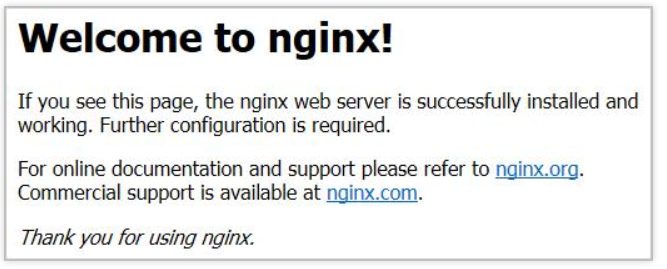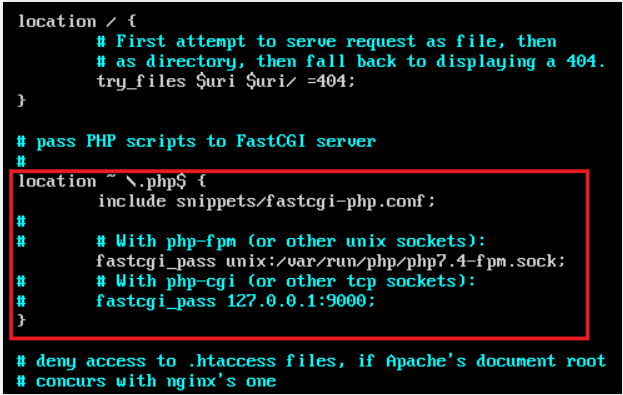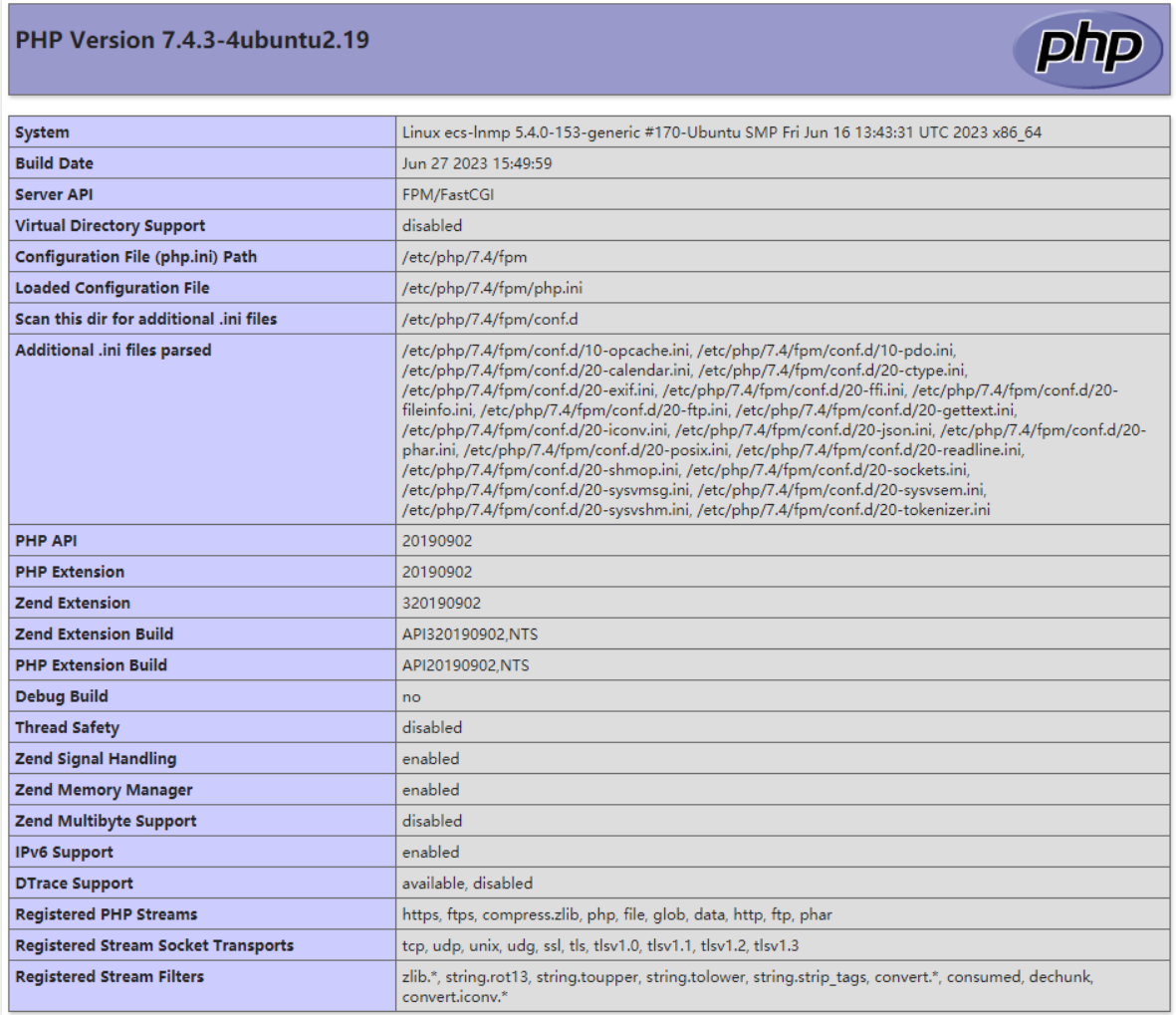简介
本文主要介绍了在天翼云上如何使用弹性云主机的Linux实例手工搭建LNMP平台的Web环境。本文档以Ubuntu 20.04 64位操作系统为例。
前提条件
1、弹性云主机已绑定弹性公网IP。
2、弹性云主机所在安全组添加了如下表所示的安全组规则。
| 方向 | 协议/应用 | 端口/范围 | 源地址 |
|---|---|---|---|
| 入方向 | HTTP(80) | 80 | 0.0.0.0/0 |
资源规划
本次实践所用的资源配置及软件版本如下表中所示。当您使用不同的硬件规格或软件版本时,本指导中的命令及参数可能会发生改变,需要您根据实际情况进行调整。
| 资源 | 资源说明 | 成本说明 |
|---|---|---|
| 弹性云主机 | 计费模式:按需计费 规格:s6.large.2 镜像:Ubuntu 20.04 64bit 系统盘:40G 弹性公网IP:自动分配 公网带宽:按流量计费 带宽大小:5 Mbit/s |
ECS涉及以下几项费用: 云主机 云硬盘 弹性公网IP |
| Nginx | 是一个高性能的HTTP和反向代理web服务器。 | 免费 |
| MySQL | 是一款开源的关系数据库软件。 | 免费 |
| PHP | 是一款开源软件,用于Web开发。 | 免费 |
操作步骤
1、安装Nginx。
a.登录弹性云主机。
b.执行以下命令安装Nginx。
sudo apt-get update
sudo apt-get install nginx
c.调整防火墙(可选)。
UFW(Uncomplicated Firewall)是一个iptables的接口,可以简化配置防火墙的过程。Ubuntu默认安装了UFW,执行以下命令查看防火墙的状态。
sudo ufw status
如果你没有也不想开启防火墙,则可以直接跳过此步骤,如果你想要开启防火墙可以通过以下命令实现。
sudo ufw enable
之后再次检查防火墙状态验证是否成功开启防火墙。
在测试Nginx之前,需要重新配置我们的防火墙软件以允许访问Nginx。执行以下命令,将Nginx自动注册在UFW。
sudo ufw app list
回显信息:
Available applications:
Nginx Full
Nginx HTTP
Nginx HTTPS
...
- Nginx Full:此配置文件打开端口 80(正常,未加密的Web流量)和端口443(TLS / SSL加密流量)
- Nginx HTTP:此配置文件仅打开端口 80(正常,未加密的Web流量)
- Nginx HTTPS:此配置文件仅打开端口 443(TLS / SSL加密流量)
执行以下命令确保防火墙允许HTTP和HTTPS连接。
sudo ufw allow 'Nginx Full'
d.验证Nginx是否正常工作。
在浏览器中通过域名或者IP地址进行访问Nginx,如果Nginx正常启动则会打开Welcome to nginx的欢迎页面。
使用浏览器访问 “http://云主机IP地址”,显示如下页面,说明Nginx安装成功

2、安装MySQL。
a.执行以下命令安装MySQL。
sudo apt -y install mysql-server
b.查看MySQL运行状态。
sudo systemctl status mysql
mysql.service - MySQL Community Server
Loaded: loaded (/lib/systemd/system/mysql.service; enabled; vendor preset: enabled)
Active: active (running) since Wed 2023-07-26 15:57:29 CST; 22min ago
Main PID: 10770 (mysqld)
Status: "Server is operational"
Tasks: 37 (limit: 4217)
Memory: 364.9M
CGroup: /system.slice/mysqld.service
└─10770 /usr/sbin/mysqld
Jul 26 15:57:29 ecs-ubuntu systemd[1]: Starting MySQL Community Server...
Jul 26 15:57:29 ecs-ubuntu systemd[1]: Started MySQL Community Server.
c.执行以下命令,进入MySQL。
sudo mysql
d.执行以下命令,设置root用户密码。
ALTER USER 'root'@'localhost' IDENTIFIED WITH mysql_native_password by 'newpassword';
其中'newpassword'为待设置的密码。
e.执行以下命令,退出MySQL数据库。
exit;
f.执行以下命令,并按照回显提示信息进行操作,加固MySQL。
mysql_secure_installation
Securing the MySQL server deployment.
Enter password for user root: #输入步骤4中设置的root用户密码
The 'validate_password' component is installed on the server.
The subsequent steps will run with the existing configuration of the component.
Using existing password for root.
Estimated strength of the password: 100
Change the password for root ? ((Press y|Y for Yes, any other key for No) : Y #是否更改root用户密码,输入Y
New password: #设置新的root用户密码
Re-enter new password: #再次输入密码
Estimated strength of the password: 100
Do you wish to continue with the password provided?(Press y|Y for Yes, any other key for No) : Y #确认使用已设置的密码,输入Y
By default, a MySQL installation has an anonymous user,
allowing anyone to log into MySQL without having to have
a user account created for them. This is intended only for
testing, and to make the installation go a bit smoother.
You should remove them before moving into a production
environment.
Remove anonymous users? (Press y|Y for Yes, any other key for No) : Y #是否删除匿名用户,输入Y
Success.
Normally, root should only be allowed to connect from 'localhost'. This ensures that someone cannot guess at the root password from the network.
Disallow root login remotely? (Press y|Y for Yes, any other key for No) : Y #禁止root远程登录,输入Y
Success.
By default, MySQL comes with a database named 'test' that anyone can access. This is also intended only for testing, and should be removed before moving into a production environment.
Remove test database and access to it? (Press y|Y for Yes, any other key for No) : Y #是否删除test库和对它的访问权限,输入Y
- Dropping test database...
Success.
- Removing privileges on test database...
Success.
Reloading the privilege tables will ensure that all changes
made so far will take effect immediately.
Reload privilege tables now? (Press y|Y for Yes, any other key for No) : Y #是否重新加载授权表,输入Y
Success.
All done!
3、安装PHP。
a.执行以下命令,安装PHP。
sudo apt update
sudo apt install php-fpm
b.执行以下命令,验证PHP的安装版本。
php -v
回显如下类似信息:
PHP 7.4.3-4ubuntu2.19 (cli) (built: Jun 27 2023 15:49:59) ( NTS )
Copyright (c) The PHP Group
Zend Engine v3.4.0, Copyright (c) Zend Technologies
with Zend OPcache v7.4.3-4ubuntu2.19, Copyright (c), by Zend Technologies
c.执行以下命令,查看PHP运行状态。
systemctl status php7.4-fpm
回显如下信息:
● php7.4-fpm.service - The PHP 7.4 FastCGI Process Manager
Loaded: loaded (/lib/systemd/system/php7.4-fpm.service; enabled; vendor preset: enabled)
Active: active (running) since Mon 2023-07-31 17:33:35 CST; 3min 50s ago
Docs: man:php-fpm7.4(8)
说明回显信息中若出现“lines 1-16/16 (end)”,可按q键退出。
d.修改Nginx配置文件以支持PHP。
1.执行以下命令,打开Nginx默认的配置文件。
sudo vim /etc/nginx/sites-enabled/default
2.按i键进入编辑模式。
3.修改打开的Nginx配置文件。
在server{}内,找到index开头的配置行,在该行中添加index.php。

在server{}内找到location ~ .php$ {},去除以下配置行的注释符号。

4.按Esc键退出编辑模式,并输入:wq保存后退出。
e.执行以下命令,重新载入nginx的配置文件。
sudo systemctl restart nginx
4、浏览器访问测试。
a.在Nginx网站根目录中,新建phpinfo.php文件。
sudo vim /var/www/html/phpinfo.php
b.按i键进入编辑模式。
c.修改打开的“phpinfo.php”文件,将如下内容写入文件。
<?php echo phpinfo(); ?>
d.按Esc键退出编辑模式,并输入:wq保存后退出。
e.使用浏览器访问“http://服务器IP地址/phpinfo.php”,显示如下页面,说明环境搭建成功。

